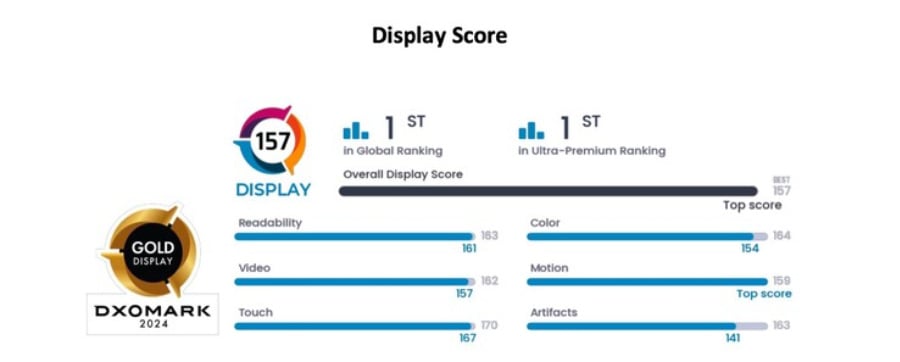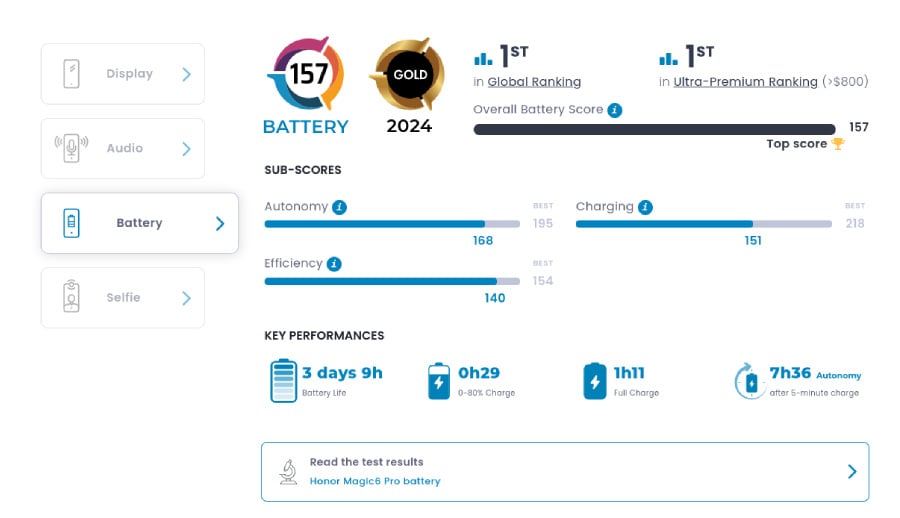Honor recently introduced the Magic 6 Pro smartphone globally. Shortly after its release, DxOMark also released the first analysis of the device. And early results seem quite impressive.
DxOMark’s assessment highlights the Magic 6 Pro’s impressive 6.8-inch AMOLED display, which has now claimed the top spot in its rankings, surpassing the previous leader, the Samsung Galaxy S24 Ultra.
With a score of 157 points, the Magic 6 Pro outperformed the Galaxy S24 Ultra by two points and the Pixel 8 Pro by three points. The Apple iPhone 15 Pro Max, in comparison, ranked tenth with 149 points.

DxOMark praised the Magic 6 Pro for its exceptional motion handling, providing users with a great experience for watching videos or playing games. The phone’s smooth playback and minimal motion blur contributed to its top score in motion.
However, DxOMark’s tests revealed some limitations of the display, such as noticeable color shifts at extreme viewing angles and distracting patterns in low-light conditions with monochrome content.
While Honor advertises a peak brightness of 5000 nits, achieving this brightness level requires specific HDR scenarios; under regular sunlight, it falls short compared to competitors.
Beyond its display, the Magic6 Pro also shines in other areas. DxOMark’s battery tests demonstrated the benefits of its large battery and efficient Snapdragon 8 Gen 3 processor, earning it the highest score of 157 points.

The phone offers impressive runtimes, lasting 35 hours for calls, 50 hours for music streaming, and 15 hours for gaming. However, heavy camera usage notably reduces battery life to around 4 hours and 39 minutes. But this isn’t surprsing.
Lastly, the Magic6 Pro’s 50MP ultra-wide-angle selfie camera also impressed reviewers. It dethroned the iPhone 15 Pro Max thanks to its ability to capture sharp group selfies with its wide depth of field, as well as delivering higher resolution images overall.
The selfie camera received praise for its white balance, color reproduction, noise control, and dynamic range, though it loses some detail in low light due to aggressive noise reduction and shows occasional video sharpness inconsistencies.
Related:
- HONOR Pad 9 mid-range tablet launched at MWC 2024 feat. 2.5K display
- Honor MagicBook Pro 16 AI-powered laptop launched at MWC: Intel Core Ultra 7 & RTX 4060
- MWC 2024: Honor Magic V2 RSR Arrives In Global Markets
- Xiaomi 13 Ultra Premium Camera Phone is now only $799
- Get $100 OFF on Xiaomi 14 Pro at Giztop (1TB Variant)
- Lenovo Legion Y700 2023: Save $100 on this 8-inch gaming Android tablet
- How to add/remove someone in a WhatsApp group (with screenshots)







